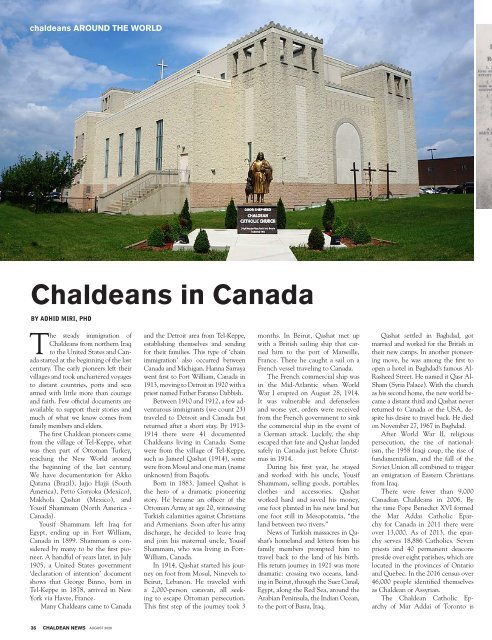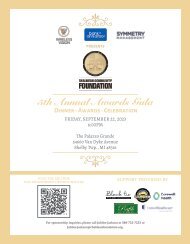AUGUST 2020
You also want an ePaper? Increase the reach of your titles
YUMPU automatically turns print PDFs into web optimized ePapers that Google loves.
chaldeans AROUND THE WORLD<br />
Chaldeans in Canada<br />
BY ADHID MIRI, PHD<br />
The steady immigration of<br />
Chaldeans from northern Iraq<br />
to the United States and Canada<br />
started at the beginning of the last<br />
century. The early pioneers left their<br />
villages and took unchartered voyages<br />
to distant countries, ports and seas<br />
armed with little more than courage<br />
and faith. Few official documents are<br />
available to support their stories and<br />
much of what we know comes from<br />
family members and elders.<br />
The first Chaldean pioneers came<br />
from the village of Tel-Keppe, what<br />
was then part of Ottoman Turkey,<br />
reaching the New World around<br />
the beginning of the last century.<br />
We have documentation for Akko<br />
Qarana (Brazil), Jajjo Hajji (South<br />
America), Petto Goryoka (Mexico),<br />
Makhola Qashat (Mexico), and<br />
Yousif Shammam (North America -<br />
Canada).<br />
Yousif Shammam left Iraq for<br />
Egypt, ending up in Fort William,<br />
Canada in 1899. Shammam is considered<br />
by many to be the first pioneer.<br />
A handful of years later, in July<br />
1905, a United States government<br />
‘declaration of intention’ document<br />
shows that George Binno, born in<br />
Tel-Keppe in 1878, arrived in New<br />
York via Havre, France.<br />
Many Chaldeans came to Canada<br />
and the Detroit area from Tel-Keppe,<br />
establishing themselves and sending<br />
for their families. This type of ‘chain<br />
immigration’ also occurred between<br />
Canada and Michigan. Hanna Sarraya<br />
went first to Fort William, Canada in<br />
1913, moving to Detroit in 1920 with a<br />
priest named Father Faranso Dabbish.<br />
Between 1910 and 1912, a few adventurous<br />
immigrants (we count 23)<br />
traveled to Detroit and Canada but<br />
returned after a short stay. By 1913-<br />
1914 there were 41 documented<br />
Chaldeans living in Canada. Some<br />
were from the village of Tel-Keppe,<br />
such as Jameel Qashat (1914), some<br />
were from Mosul and one man (name<br />
unknown) from Baqofa.<br />
Born in 1883, Jameel Qashat is<br />
the hero of a dramatic pioneering<br />
story. He became an officer of the<br />
Ottoman Army at age 20, witnessing<br />
Turkish calamities against Christians<br />
and Armenians. Soon after his army<br />
discharge, he decided to leave Iraq<br />
and join his maternal uncle, Yousif<br />
Shammam, who was living in Fort-<br />
William, Canada.<br />
In 1914, Qashat started his journey<br />
on foot from Mosul, Nineveh to<br />
Beirut, Lebanon. He traveled with<br />
a 2,000-person caravan, all seeking<br />
to escape Ottoman persecution.<br />
This first step of the journey took 3<br />
months. In Beirut, Qashat met up<br />
with a British sailing ship that carried<br />
him to the port of Marseille,<br />
France. There he caught a sail on a<br />
French vessel traveling to Canada.<br />
The French commercial ship was<br />
in the Mid-Atlantic when World<br />
War I erupted on August 28, 1914.<br />
It was vulnerable and defenseless<br />
and worse yet, orders were received<br />
from the French government to sink<br />
the commercial ship in the event of<br />
a German attack. Luckily, the ship<br />
escaped that fate and Qashat landed<br />
safely in Canada just before Christmas<br />
in 1914.<br />
During his first year, he stayed<br />
and worked with his uncle, Yousif<br />
Shammam, selling goods, portables,<br />
clothes and accessories. Qashat<br />
worked hard and saved his money,<br />
one foot planted in his new land but<br />
one foot still in Mesopotamia, “the<br />
land between two rivers.”<br />
News of Turkish massacres in Qashat’s<br />
homeland and letters from his<br />
family members prompted him to<br />
travel back to the land of his birth.<br />
His return journey in 1921 was more<br />
dramatic: crossing two oceans, landing<br />
in Beirut, through the Suez Canal,<br />
Egypt, along the Red Sea, around the<br />
Arabian Peninsula, the Indian Ocean,<br />
to the port of Basra, Iraq.<br />
Qashat settled in Baghdad, got<br />
married and worked for the British in<br />
their new camps. In another pioneering<br />
move, he was among the first to<br />
open a hotel in Baghdad’s famous Al-<br />
Rasheed Street. He named it Qasr Al-<br />
Sham (Syria Palace). With the church<br />
as his second home, the new world became<br />
a distant third and Qashat never<br />
returned to Canada or the USA, despite<br />
his desire to travel back. He died<br />
on November 27, 1967 in Baghdad.<br />
After World War II, religious<br />
persecution, the rise of nationalism,<br />
the 1958 Iraqi coup, the rise of<br />
fundamentalism, and the fall of the<br />
Soviet Union all combined to trigger<br />
an emigration of Eastern Christians<br />
from Iraq.<br />
There were fewer than 9,000<br />
Canadian Chaldeans in 2006. By<br />
the time Pope Benedict XVI formed<br />
the Mar Addai Catholic Eparchy<br />
for Canada in 2011 there were<br />
over 13,000. As of 2013, the eparchy<br />
serves 18,886 Catholics. Seven<br />
priests and 40 permanent deacons<br />
preside over eight parishes, which are<br />
located in the provinces of Ontario<br />
and Quebec. In the 2016 census over<br />
46,000 people identified themselves<br />
as Chaldean or Assyrian.<br />
The Chaldean Catholic Eparchy<br />
of Mar Addai of Toronto is<br />
36 CHALDEAN NEWS <strong>AUGUST</strong> <strong>2020</strong>

















